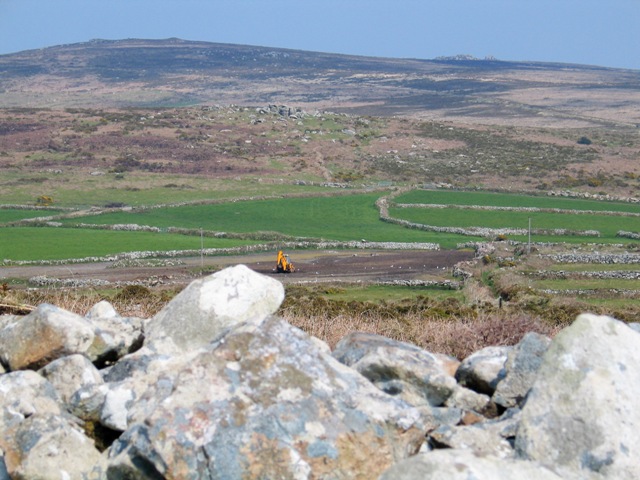
There are so many fascinating Ancient Sites to explore here in West Cornwall. This week, we revisited the once mighty Iron Age fort of Chun Castle again. A Castle set beside the remarkable preserved Chun Quoit, in a commanding position high on the downs, with spectacular views over West Penwith.
I had read that the Castle and Quoit had recently been cleared by volunteers, so it was a perfect time to climb up onto Chun Downs once more and absorb the atmosphere of distant times.
Our visit to Chun Castle
So many years have passed since we last climbed to Chun castle but the temptation of reading that the vegetation was freshly cleared led us back once more, to wander in the Iron Age hill fort already old 2000 years ago.

There is something reassuringly permanent about the ancient places of Cornwall. Parking was still in the farmyard as we remembered and the white stone that marks the beginning of the path is still set at the base of the hill just where the pastureland turns to scrub.

We were soon panting in huge lungful of cool clear air as the gradient began to take its toll but forged onwards picking our way up a track as so many other people had done before us over thousands of years.
We finally picked our way through the defensive banks and ditches to the entrance – originally this would have been staggered between the walls for defensive purposes but these day the front door is invitingly open.

The massive walls that stood over thousand of years are no more than a deep scatter of stones robbed to build Penzance Madron and Madron workhouse but still giving the impression of the immense width and what might have been so very long ago.

Tread carefully in Chun castle, there is still history to be found lying amongst the scatter of stones – I was intrigued to find a stone drilled in a regular pattern and after making later enquiries to Ancient Cornwall on Facebook I can now tell you

“It’s a merriment stone. The holes were packed with black powder and then lit. It’s said that with the right amount powder in the holes some stones could play a simple tune.” Ancient Cornwall
Cornish Archaeology 26 1987 p 81 “Drill holes and merriment holes Drilling contests are a well recorded feature of feast days in mining and quarrying areas. The drill holes thereby produced are regular in size and straight-sided and the surface of the drilled boulder is usually peppered with them. Such stones would sometimes be used to stage ‘firework displays’ when the holes were packed with gunpowder and linked by a trail of powder which, when set alight, would go off with a series of spectacular bangs and flashes. These holes were once known as ‘merriment holes’ (P. Herring, pers.comm.) “

Although abandoned over 2000 years ago here was a brief reoccupation of the castle four or five hundred years later and oblong huts and a furnace were built over the original round structures within the stronghold so closely guarding the smelting of tin to produce ingots. Pottery dating to 2nd and 3rd century BC.

We carefully explored and circled the walls that day pausing to take in the sweeping views to the sea, the villages in the valleys looking like tiny models so far below and the old Engine houses for the Tin mine and finally the unchanging landscape of the field systems.



We think we spotted the well again the steps were still clearly visible when Borlase visited in but these days a moist green depression marks the spot.

For a guide to a suggested walk near Chun castle https://www.southwestcoastpath.org.uk/print-walk/705/
Chun Quoit

Finally we moved on to the Chun Quoit believed to have been built around 2400 B.C. set within sight of the castle entrance but separated in time by nearly four thousand years.

This ancient place of ceremony set high above the sea seemed almost untouched and unyielding to time set on the heathland still clothed with the spare beauty of the bleached grasses of winter.


Our journey to Chun Castle – other sites nearby

It has been several years since we visited so many of the Ancient sites of West Cornwall and I had plans to revisit Chun Castle so many times that somehow the chance has never come until now.
It was early afternoon by the time we reluctantly passed Madron Well saving it for another day but stopped to dallying en route at Lanyon Quoit – impressively tall still despite being reset at a lower height after it collapsed after gale (probably aided by the enthusiastic excavations of treasure hunters).


We passed the packed car park for Men-an-Tol along the way on our right – this is an ancient healing stone with a captivating walk across the downs Bronze Age barrows and the Nine Maidens stone Circle. Chun Castle that lays just a little further on the opposite side of the road.
Sat Nav postcode : – TR20 8NR
Discover more from Ednovean Farm
Subscribe to get the latest posts sent to your email.
